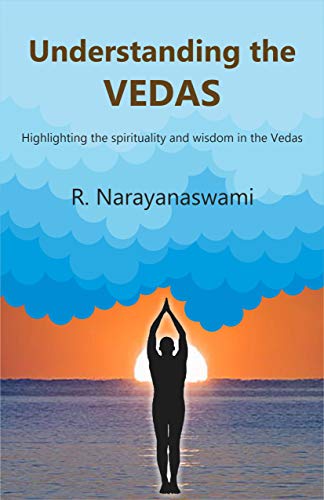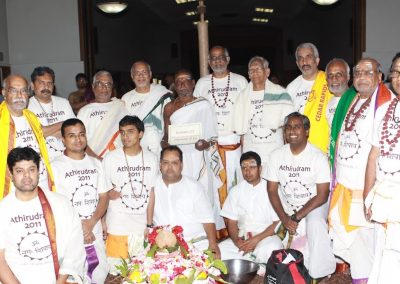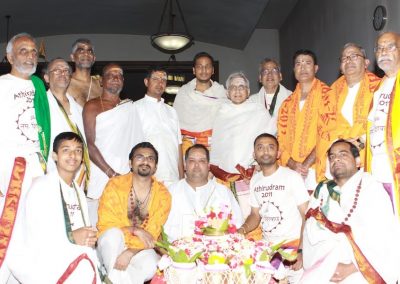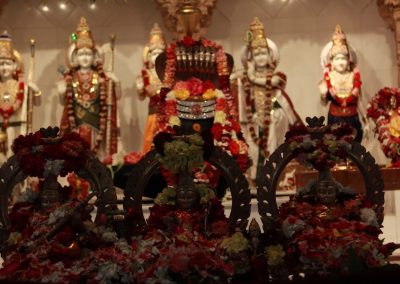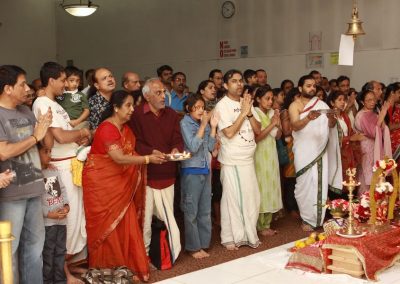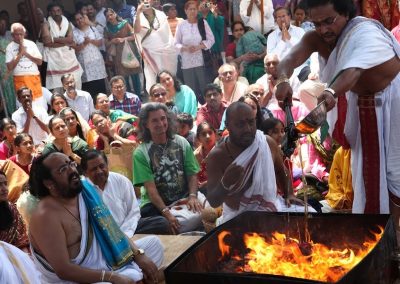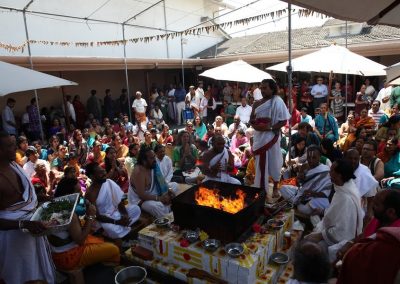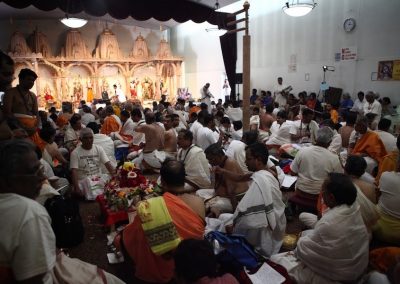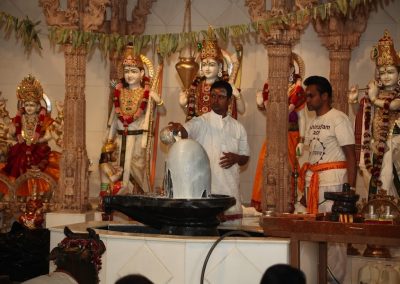Athirudra Maha Yajna Conducted in Cerritos CA during May 20 to May 30, 2011
|
The Athirudra Maha Yajna is the highest form of worship to Lord Siva. It is a very rare opportunity to participate in or witness “The Athirudra Maha Yajna” in one’s lifetime. Sri Kanchi Kama Koti Peetha Acharya said: “The four Vedas (Rig, Yajur, Sama and Atharva) are the Rudram, Ekadasa Rudram, Maha Rudram and Athi Rudram; The highlights of The Athirudra Maha Yajna:
The first day of the program opens with Ganapathi and Navagraha Homams (for This will be followed, in subsequent days, by Chandi Homam, Trishathi Kumkuma |
What is Ati Rudram?
Rudra is another name for Lord Siva. References to Him as Lord Rudra Siva are fairly common. Sri Rudram (also known as Namakam) and Chamakam (so called due to the repeated occurrences of the words ‘cha’ and ‘mey’) are among the sacred mantras of Yajur Veda. These mantras occur in the fourth Canto (Kanda) of the Taittiriya Samhita of Yajur Veda.
Sri Rudram is referred to as ‘Shatarudriyam’ because it occurs in all one hundred and one branches (shakhas) of Yajur Veda and because Rudra is described in hundreds of forms. It is also referred to as ‘Rudropanishad’, giving it the status of vedantic or ‘jnana’ literature.
A verse in the Vayu Purana states:
विध्यासु श्रुतिक्रिष्ट रुद्रैकादशिनो श्रुतौ
तत्र पन्चाक्शरि तस्याम् शिव इत्यक्षरद्वयम्
Vidhyaasu Sruthikrishta Rudraikaadashino sruthou
Thathra Panchaakshari Thasyaam Shiva Ithyaksharadvayam
Among the Vidyas or sources of learning, the Vedas are supreme; in the Vedas the Rudra Ekadasi is supreme; in the Rudram, the Panchaakshari Mahamantram is supreme; in the Panchaakshari, the two letters Si-va stand Supreme
Benefits of Chanting Sri Rudram
Swami Vivekananda has stated, “Each soul is potentially divine”. All human beings have this potential. The question is how each human being can realize this potential of divinity. Our Sastras tell us that this potential can be realized by everyone through devotion (bhakthi); yoga and meditation (dhyana); selfless action and service (karma yoga); and knowledge (jnana yoga). The Vedic Mantras are meant to help us in all these ways. Sri Rudram is an outstanding text of Vedic mantras addressed to Lord Siva as the Supreme Being. For the majesty of their diction and the sweetness of their sound, Sri Rudram tops the list of all Veda Mantras. The chanting of Sri Rudram invokes Lord Siva’s various attributes and aspects. Sri Rudram is believed to please Lord Siva more than any other mantra.
Chanting Sri Rudram provides the material enjoyment (‘bhukthi‘ or ‘bhoga‘) prescribed in the ‘Karma Kanda of Vedas’ to the devotees. It also delivers the liberation (‘mukthi‘) prescribed in ‘Jnana Kanda of Vedas’. It is stated in the Brighu Valli of Taittiriya Upanishad that “tannama ithyupAsEtha, namyanthEsmai kAmAh”, meaning, “one who worships Him with Namah, shall have his worldly (dharmic) desires fulfilled”. Since Sri Rudram contains over 100 references to the ‘namah’ chant, one who chants (vachasa) Sri Rudram with devotion and offers prostrations to Him with his mind (manasa) will have all his dharmic desires fulfilled by authority of this Upanishadic passage.
Vedic literature also states:
व्रिक्षस्य मूलसेकेन शाखह पुष्यन्ति वै यथा
शिवे रुद्रजपात् प्रीते प्रीता एवस्य देवताह्
अथो रुद्रजपादेवह् मुक्ति भुक्ति प्रसिध्यश्चतु
Vrikshasya Moolasekena Shaakhaha Pushyanthi Vai Yatha
Shive Rudrajapaath Preethe Preetha Evasya Devathaah
Atho Rudrojapadevah Mukthi Bhukthi Prasidhyaschathu
As by pouring water at the root of a tree, all its branches are nourished, by pleasing Sri Rudra, through Rudrajapa, all the Devas are pleased. One attains Bhukthi, and Mukthi enjoyment and freedom from the ills of the world by chanting the Sri Rudram with devotion.
A verse in the Vayu Purana states:
चमकम् नमकम् चैव पौरुषसूक्तम् तथैव च
नित्यम् त्रयम् प्रयुज्यानो ब्रह्मलोके महीयते
Chamakam Namakam Chaiva Pourushasooktham Thathaiva Cha
Nithyam Trayam Prayujyaano Brahmaloke Maheeyathe
A person chanting and applying daily the Chamakam, Namakam and Purusha Sooktham is honored in Brahma Loka. In the Rudraikadashini, Maharudra and Athirudra Japams, Purusha Sooktham is chanted during Mahanyasam and after the Ekadasa Rudra Japam, thus, the three Veda mantras of Namakam, Chamakam and Purusha Sooktham will be chanted daily during the Athirudra Maha Yajna.
What is Athirudram?
The following ways of chanting Sri Rudram (Namakam) and Chamakam are prescribed in our scriptures:
- One round of ‘Namakam-Chamakam’ chanting: One chanting of all eleven anuvakas (stanzas) of Namakam (Sri Rudram) and all eleven anuvakas of Chamakam by one person.
- The Rudram: Chanting Namakam eleven times and Chamakam once by one person. This is done as follows:
- Chant the first round of Namakam, followed by the first anuvaka of Chamakam;
- Chant the second round of Namakam followed by the second anuvaka of Chamakam;
- Chant the third round of Namakam followed by the third anuvaka of Chamakam;
- …… so on until 11 rounds of Namakam and one round of Chamakam is completed.
In some parts of India, the above definition is known as “The Ekadasa Rudram” because they define the chanting of all eleven anuvakas of Namakam along with one anuvaka of Chamakam by one person as “The Rudram”.. However, this article uses the above definition (i.e., chanting 11 rounds of Namakam and one full round of Chamakam) for ‘The Rudram’.
- The Rudraikadashini: Eleven persons, known as “Ritwiks“, constitute a ‘gana’. When all eleven members of one gana chant “The Rudram” (or “Ekadasa Rudram” as defined above) it is called “The Rudraikadashini”. Since each member of the eleven member ‘gana’ chants Namakam eleven times and Chamakam once, the total number of Namakam chants is 121 and the total number of Chamakam chants is 11 for ‘The Rudraikadashini’.
- The Maharudram: 121 Ritwiks grouped into eleven ganas (each gana consisting of eleven Ritwiks) chanting “The Rudram” is known as “The Maharudram“. “The Maharudram”, consists of 1,331 Namakam chants and 121 Chamakam chants.
- The Athirudram: The offering of 11 Maharudrams in 11 consecutive days is known as “The Athirudram”. 121 Ritwiks participate for 11 days and chant “The Rudram” on all eleven days. The Athirudram consists of 14,641 Namakam chants and 1,331 Chamakam chants.
In all of the above functions – Rudraikadashini, Maharudram and Athirudram – homam equal to 10% of the japam (or ‘dasamsha homam’) will be done at the conclusion of the japam. Vasorddhara homam and Purnahuthi will also be performed at the end of the rudra homam.
Prerequisites for Ritwiks participating in Rudraikadashini, Maharudram and Athirudram:
Before participating in the above Rudram offerings, the Ritwiks must commit to personal cleanliness, purity of thought, humility and devotion to Lord Siva. The Ritwiks must make a ‘sankalpam’ for doing their best in chanting Sri Rudram and Chamakam with proper swaras and intonations (as prescribed in the Vedas) and without any errors. Additionally, the Ritwiks must begin the day’s chanting with ‘Mahanyasa’ mantra which allows them to obtain inner purity and helps them concentrate on Lord Siva.
Japam, homam and archana performed for Rudraikadashini, Maharudram and Athirudram:
As the chanting of ‘The Rudram’ proceeds, Siva Abhishekam is conducted simultaneously. The materials (dravyam) used to conduct the Abhishekam for each of the eleven (11) rounds of Namakam chant is prescribed as follows:
प्रथमम् ग़न्धतैलम् च द्वितीयम् पन्चगाव्यकम्
पन्चाम्रितम् त्रितीयम् च चतुर्थम् घ्रितमेव च
पन्चमम् पयस स्नानम् दध्न स्नानम् तु षश्टकम्
सप्तमम् मधुन स्नानम् अश्टमम् च ईक्शुडन्डजम्
नवमम् निम्बथोयम् च दशमम् नालिकेरजम्
एकदशम् ग़न्धतोयम् अथ कुम्भभिशेचनम्
Prathamam Gandhathailam Cha Dwitheeyam panchagavyakam
Panchamritham Thritheeyam Cha Chathurtham Ghrithameva Cha
Panchamam Payasaa Snaanam Dadhna Snaanam Thu Shashtakam
Sapthamam Madhuna Snaanam Ashtamam Cha Ikshudandajam
Navamam Nimbathoyam Cha Dashamam Naalikerajam
Ekadasam Gandhathoyam Atha Kumbhabhishechanam
(Oil, Panchagavyam, Panchamritham, Ghee, Milk, Buttermilk, Honey, Sugarcane juice, Lemon juice, Coconut water and Sandal-paste-in-rosewater (Chandana Kalabham) are the eleven liquids used during the eleven-rounds of chant of Namakam.)
In some places, Vibhuthi is used for the eleventh abhishekam instead of Chandana Kalabham. It is also noticed in some places that 2 items, Vibhuthi and Chandana Kalabham in that order (or vice versa) are used in the eleventh round.
Rudra Homam, Vasorddhara, Krama Archana and Kalasa Abhishekam are then performed. This is the procedure followed for all Rudraikadashini and Maharudram.
For the Athirudram, each day’s events, during the first 10 days, in general, include the following in the order shown below:
- Completion of One round of Mahanyasam
- Completion of eleven rounds of Namakam and one round of Chamakam along with the 11 abhishekams,
- Completion of the Rudra Homam using the Dasamsa-basis (the ahuthis being 10% of the Japam performed).
- Completion of the Vasordhara Homam with all eleven anuvakas of Chamaka Mantra in an unbroken chanting with unbroken stream of ghee as ahuthi is performed.
- Krama Archana
- Arathi
On the 11th day, after completing the Steps 1- 6 as shown above (namely Mahanyasam, Rudra Japam, Rudra Abhishekam, Rudra Homam, Vasordhara, Krama Archana, and Arathi as was done on the prior 10 days), “The Athirudram” concludes with the following events to complete this grand offering to Lord Siva:
- Maha Purnahuthi (the final oblation), offering one’s complete self to Lord Siva. During Purnahuthi, the choicest and best items of all ahuthis done during homa are offered. During Abhishekam, Homam, Annadanam, and while planning and conducting the Yajna, one offers one’s self and services. Purnahuti is the essence of all offerings, including one’s total and final surrender.
- Abhishekam using the water from the Kalasas on which Lord Siva was invoked when the chanting started on the first day of Athirudra MahaYajna.
- Archana, Neivedyam and Maha Aarathi
As can be noticed, all such offerings to Lord Siva from ‘The Rudraikadashini’ onwards become progressively more involved culminating in the Athirudram, which is the highest offering to Lord Siva, prescribed in our scriptures.
The program planned for Athirudram-2011 at the Sanathan Dharma temple, Norwalk, California, during May 2011:
The VEDA Circle, the organizers of the Athirudra Maha Yajna at the Sanathan Dharma Temple in Norwalk, California, during May 2011 is planning to conduct the Athirudram with 121 ritwiks in 6 continuous days from May 25 to May 30, 2011 (both days inclusive) as follows:
121 ritiwks will perform 2 rounds of Ekadasa Rudra Japam, abhishekam and homam during each of the 5 days (May 25 to May 29, 2011). This will equal what is normally performed in the first 10 days of the 11-day Athirudra program described in the earlier paragraphs under Athirudram. On the sixth day, May 30, 2011, 1 round of rudra japam, abhishekam and homam will be performed that is analogous to what is normally done on the 11th day of the Athirudra program discussed in earlier paragraphs. In summary, therefore, the program planned is as follows:
First five days – from Wednesday May 25, 2011 to Sunday, May 29, 2011:
- Completion of One round of Mahanyasam
- Completion of eleven rounds of Namakam and one round of Chamakam along with the 11 abhishekams, (this is the first round of ekadasa rudra Japam and abhishekam)
- Completion of eleven rounds of Namakam and one round of Chamakam along with the 11 abhishekams, (this is the second round of ekadasa rudra Japam and abhishekam)
- Completion of the Rudra Homam using the Dasamsa-basis (the ahuthis being 10% of the Japam performed) associated with the first round of rudra japam & abhishekam.
- Completion of the Rudra Homam using the Dasamsa-basis (the ahuthis being 10% of the Japam performed) associated with the second round of rudra japam & abhishekam.
- Completion of the Vasordhara Homam with all eleven anuvakas of Chamaka Mantra in an unbroken chanting with unbroken stream of ghee as ahuthi is performed.
- Krama Archana (in the evening at 6 pm)
- Arathi (in the evening at 7 pm).
Monday May 30, 2011:
- Completion of One round of Mahanyasam
- Completion of eleven rounds of Namakam and one round of Chamakam along with the 11 abhishekams, (this corresponds to the eleventh round of ekadasa rudra Japam and abhishekam)
- Completion of the Rudra Homam using the Dasamsa-basis (the ahuthis being 10% of the Japam performed) associated with the eleventh round of rudra japam & abhishekam.
- Completion of the Vasordhara Homam with all eleven anuvakas of Chamaka Mantra in an unbroken chanting with unbroken stream of ghee as ahuthi is performed.
“The Athirudram” concludes with the following events to complete this grand offering to Lord Siva:
- Maha Purnahuthi (the final oblation), offering one’s complete self to Lord Siva. During Purnahuthi, the choicest and best items of all ahuthis done during homa are offered. During Abhishekam, Homam, Annadanam, and while planning and conducting the Yajna, one offers one’s self and services. Purnahuti is the essence of all offerings, including one’s total and final surrender.
- Abhishekam using the water from the Kalasas on which Lord Siva was invoked when the chanting started on the first day of Athirudra MahaYajna. 7. Archana, Neivedyam and Maha Aarathi
What are Yaga and Yajna?
Yaga:
Yaga is the offering of ghee, rice, rice pudding, fruits etc. to the fire (Agni) in the fire pit (Homa Kundam), constructed per guidelines laid out in the sastras, to Indra, Varuna, Navagraha or one’s favorite deity to propitiate the deities and for obtaining desired material benefits. The details of such Yaga are laid out in the ‘Brahmana’ section of the Yajur Veda.
Yajna:
Though ‘Yaga’ and ‘Yajna’ are sometimes used synonymously, ‘Yajna’ has a deeper meaning than ‘Yaga’. Yajna includes the ‘selfless’ performance of Yagas seeking only the overall welfare of the people and the community at large. Yagas are, and can be, performed for the specific attainment of material benefits. The selfless performance of Yagas for Loka Kshema and Loka Kalyana and the spiritual faith and journey towards the realization of the Supreme Being qualify such Yagas as Yajnas.
The ‘Yoga of Action’ or Karma Yoga, Chapter 3, of Bhagavad Gita states that actions performed as Yajna do not attach (as bondage) to the doer, so Lord Krishna tells Arjuna to perform all actions as ‘Yajna’ (vide verse 9). In essence, Lord Krishna suggests that people must first provide offerings to Gods and then keep what remains, so that no karma attaches as bondage to them. Verse 11 provides the interdependence of people and devas.
देवान् भावयतानेन ते देवा भावयन्तु व:
परस्परम् भावयन्त: श्रेय: परमवाप्स्यथ
Devan Bhaavayathaanena They Devah Bhavayanthu Vah
Parasparam Bhavayanthah Shreyah Paramavapsyatha
“Cherish the ‘devas’ with Yajna. May those devas cherish you (provide you with material benefits). Thus cherishing one another, you gain the highest good”
Verse 13 states that one who does not perform any Yajna and keeps all for one’s self incurs sin.
यज्ञशिष्टाशिन सन्तो मुच्यन्ते सर्वकिल्बिशै:
भुज्ञ्जते ते त्वघम् पापा ये पचन्त्यात्मकरणात्
Yajnashishtashinah Santho Muchyanthey Sarvakilbishaih
Bhunjathey They Thvagham Papaa Ye Pachanthyatmakaranaath
“The good people, living on the remnants of Yajna, are freed from all sins. On the other hand, those who cook food just for themselves eat only sin.”
There are many other passages in the Gita that extol the performance of selfless actions and service and the performance of Yajnas for Loka Kalyana.
Yajna and sacrificial offerings are well-known aspects of all religious traditions the world over. Our Vedic heritage repeatedly exhorts us of the need and responsibility on our part to ensure the continued performance of such Yajnas for the welfare of all people.
